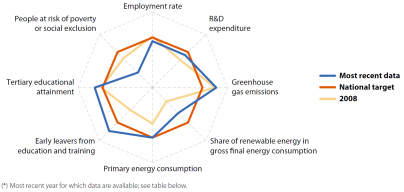Archive:Europe 2020 indicators - Cyprus
- Data from June 2017. Most recent data: Further Eurostat information, Main tables. Planned article update: July 2018.
This article is part of a set of statistical articles on Europe 2020 strategy, focusing on the situation in Cyprus.

Source: Eurostat (see dedicated web section: Europe 2020 headline indicators)
Explanations on this radar chart are available here.
Main statistical findings

Source: Eurostat (see dedicated web section: Europe 2020 headline indicators)
Cyprus exceeded its national target on tertiary educational attainment by 7.4 percentage points in 2016. In the same year, the country had also surpassed its target on early leavers from education and training by 2.3 percentage points and by 2015 had met its goal on primary energy consumption. Additionally, by 2015, Cyprus had recorded a reduction in non-ETS GHG emission compared to 1990 that was six times larger than the one envisaged in its Europe 2020 commitment. By 2015, the country was close to meeting its target on R&D expenditure and had reduced the distance to its renewable energy goal to 3.6 percentage points. However, its progress on employment and poverty reduction has reversed since the start of the economic crisis in 2008. In 2016, Cyprus’s employment rate was 6.2 percentage points below its 75 % national target. The country would also need to lift 90 000 more people out of the risk of poverty and social exclusion to meet its 2020 commitment.
Data sources and availability
More information about the origin of the data and the calculation of indicators can be obtained via the Europe 2020 indicators dedicated website.
Under 'Main tables', click on the icons next to the indicators:
- 'Explanatory texts (metadata)' for a detailed overview of the collection and compilation methods;
- 'Information on the leaf' for data availability per country.
A more general overview of quality procedures can be found in Implementation of standard reference-metadata for indicators - the ESMS Indicator Profile (ESMS-IP) (PDF file).
Context
Europe 2020 is the EU’s agenda for jobs and growth for the current decade. It emphasises smart, sustainable and inclusive growth as a way to strengthen the EU economy and prepare its structure for the challenges of the next decade. As a main objective, the strategy strives to deliver high levels of employment, productivity and social cohesion in the Member States, while reducing the impact on the natural environment.
See also
Further Eurostat information
Publications
- Smarter, greener, more inclusive - indicators to support the Europe 2020 strategy (online publication, also downloadable as PDF file)
Main tables
Dedicated section
Methodology / Metadata
- Towards robust quality management for European Statistics - Communication from the Commission COM(2011) 211 final
Other information
- Regulation (EC) No 223/2009 of 11 March 2009 on European statistics